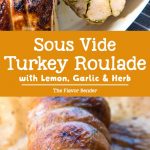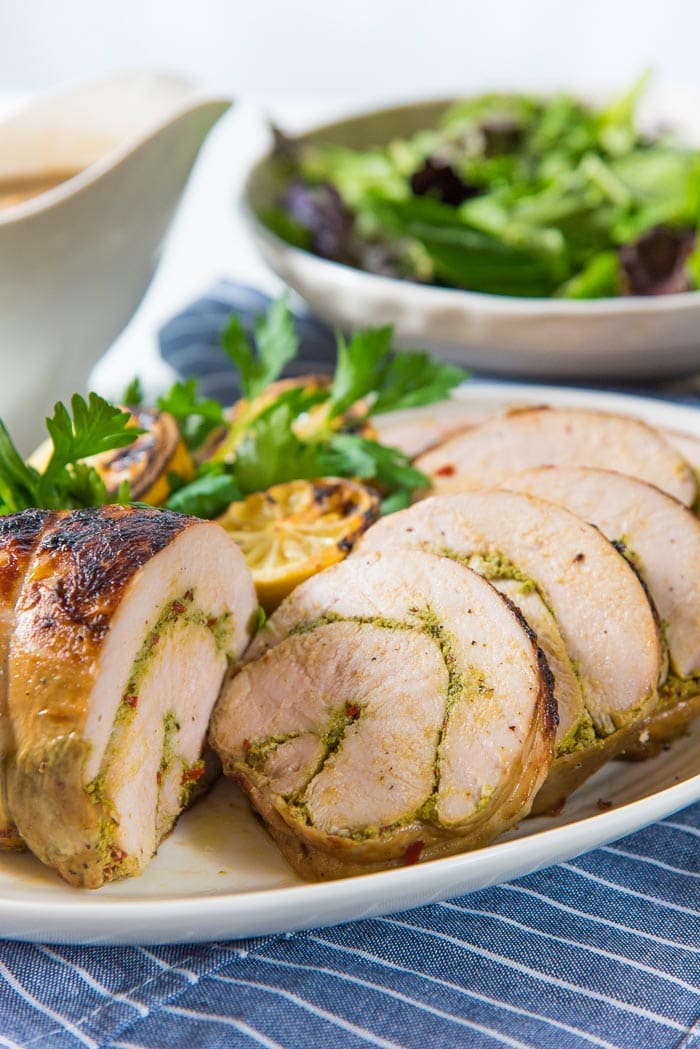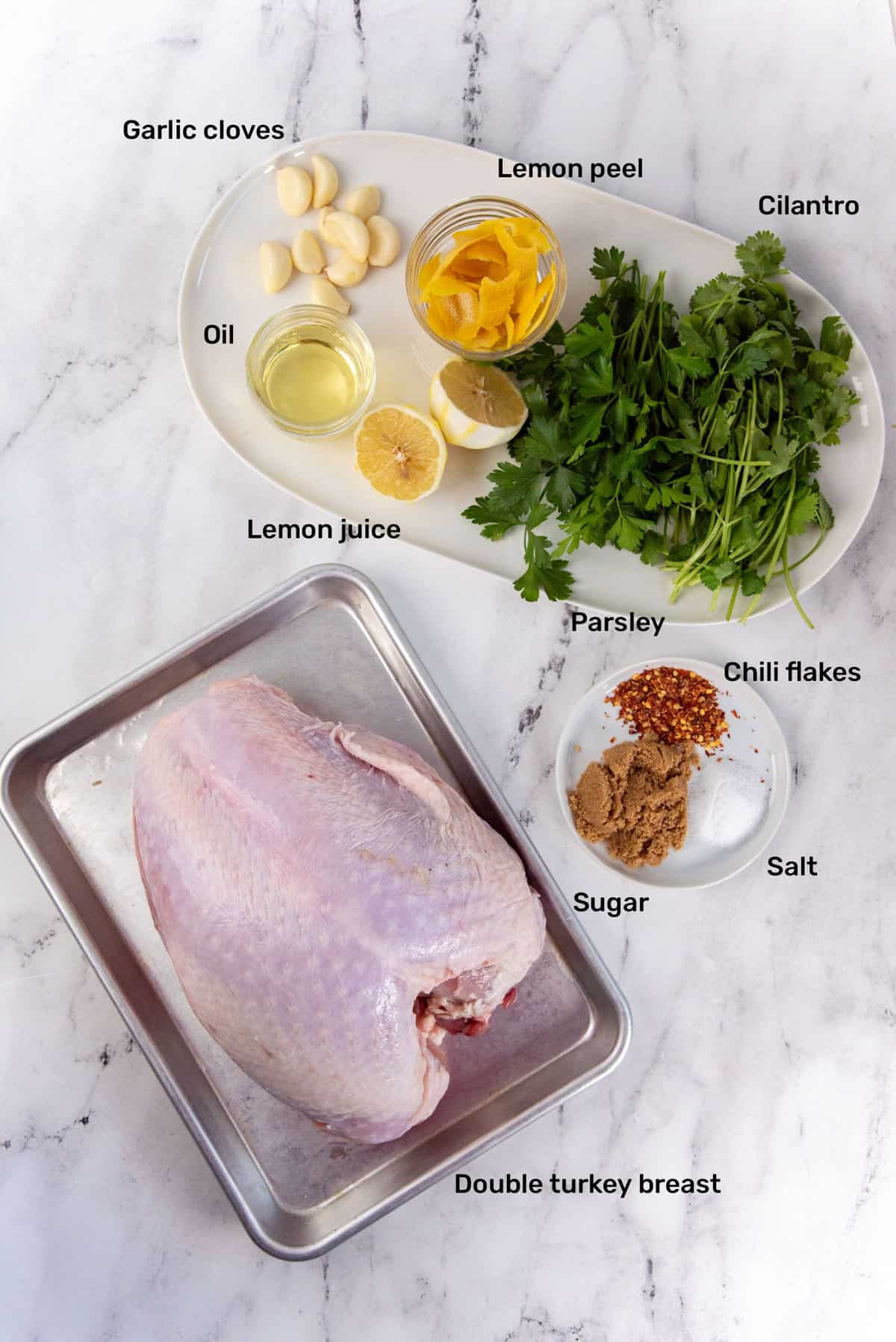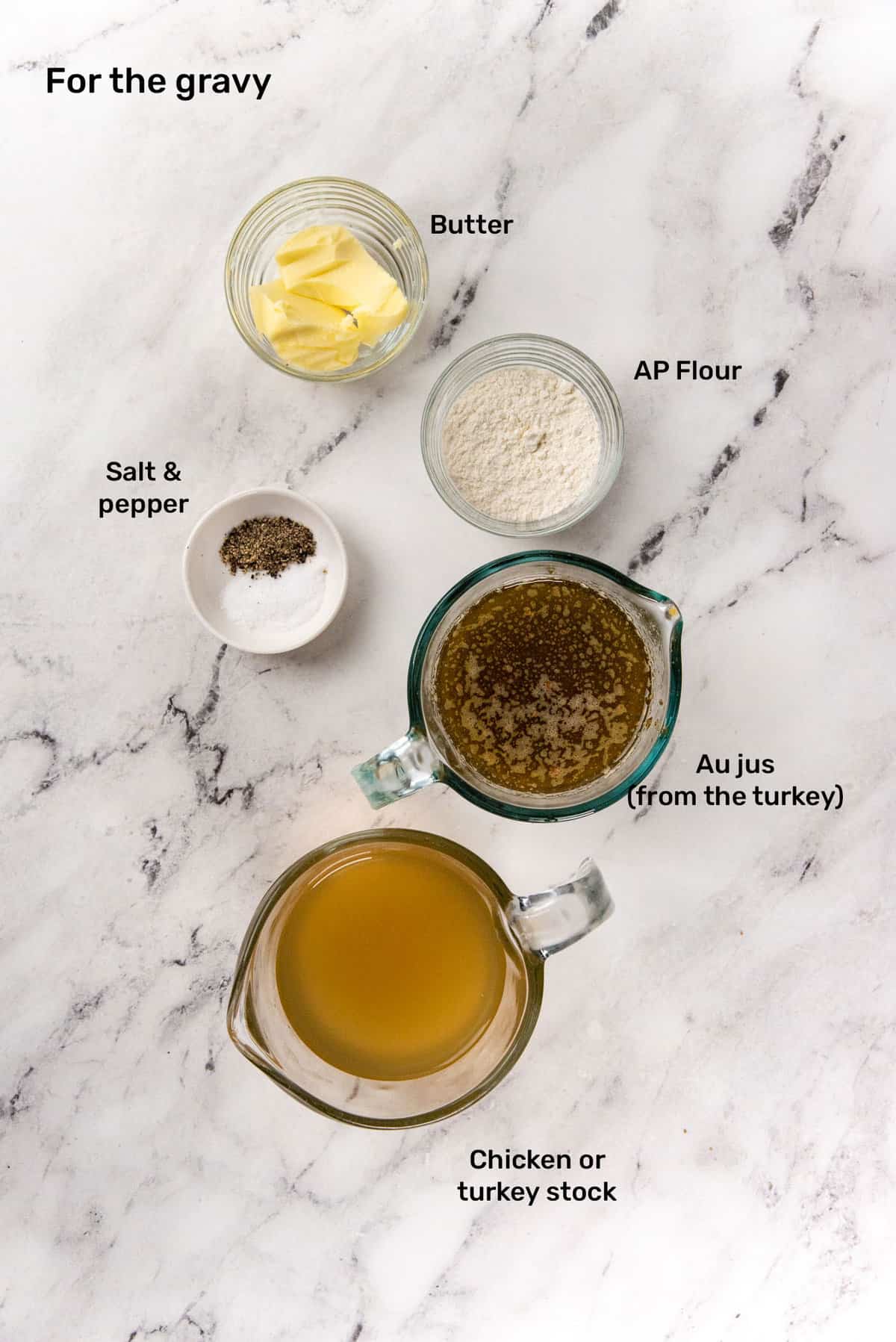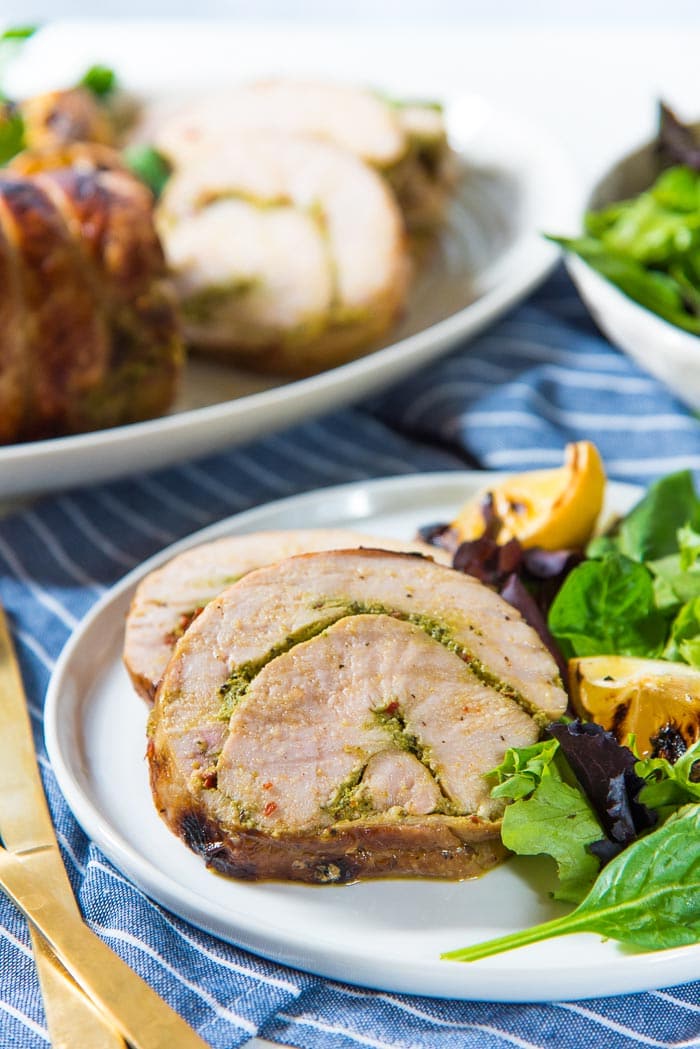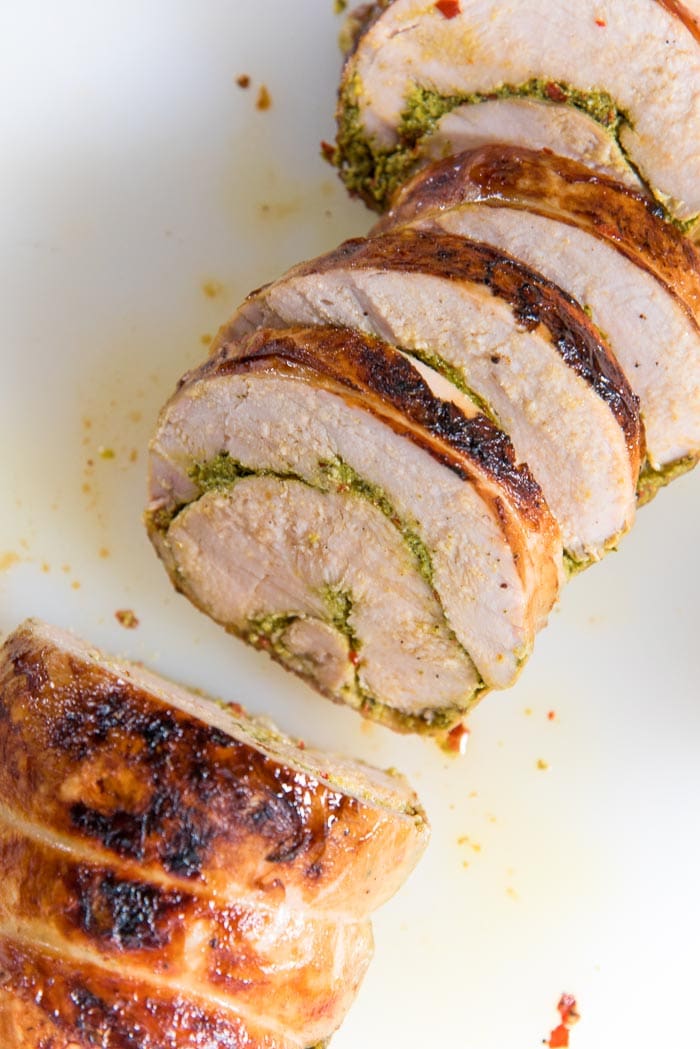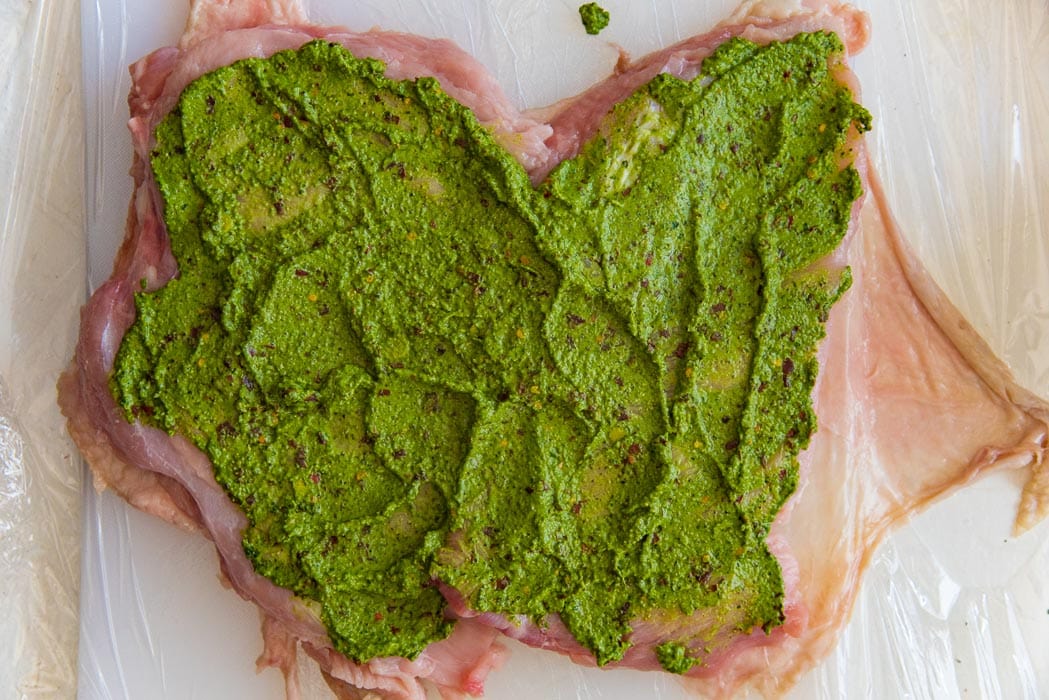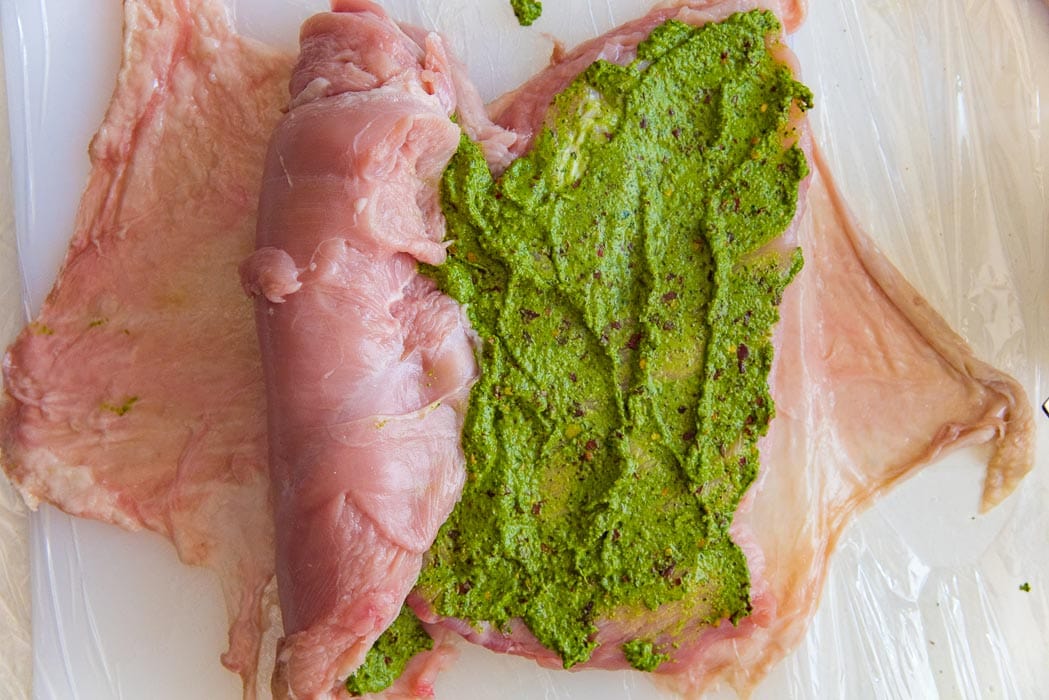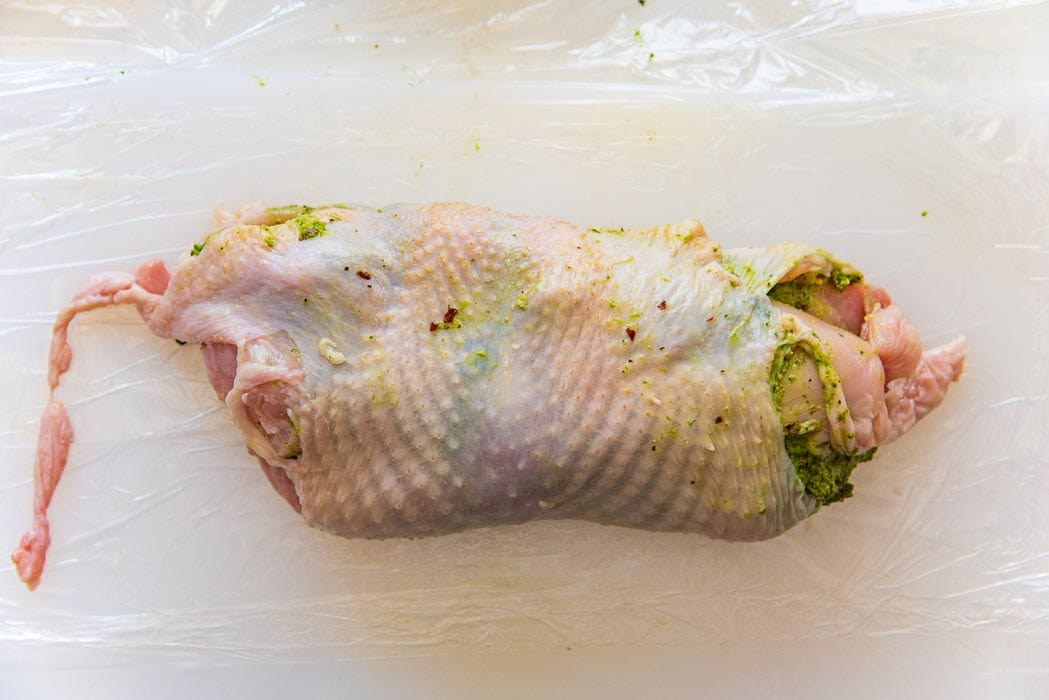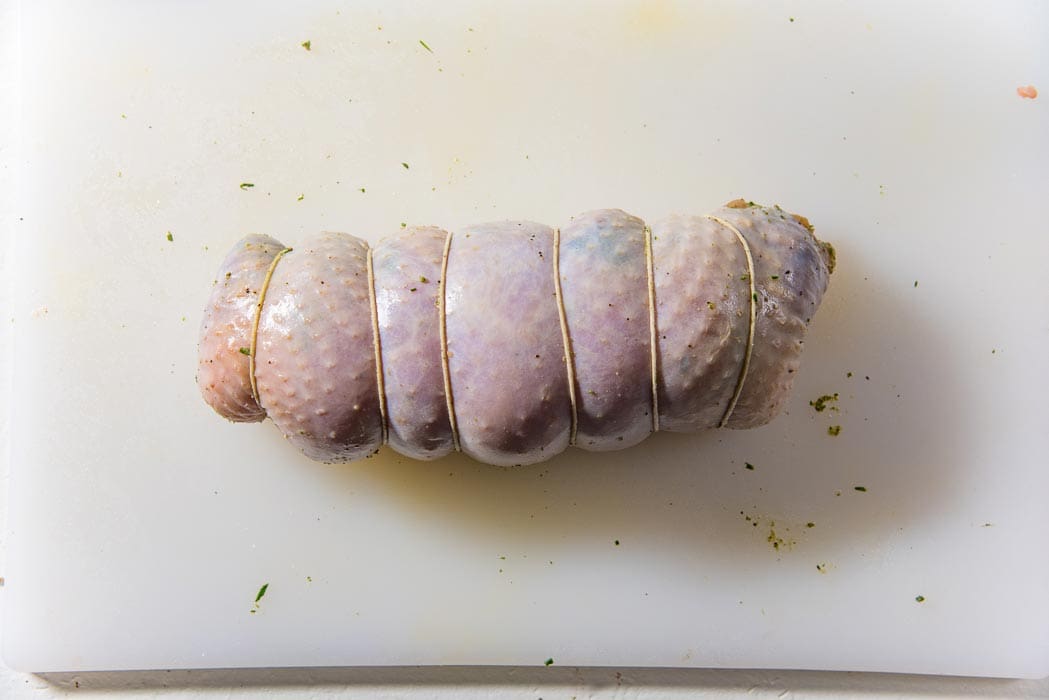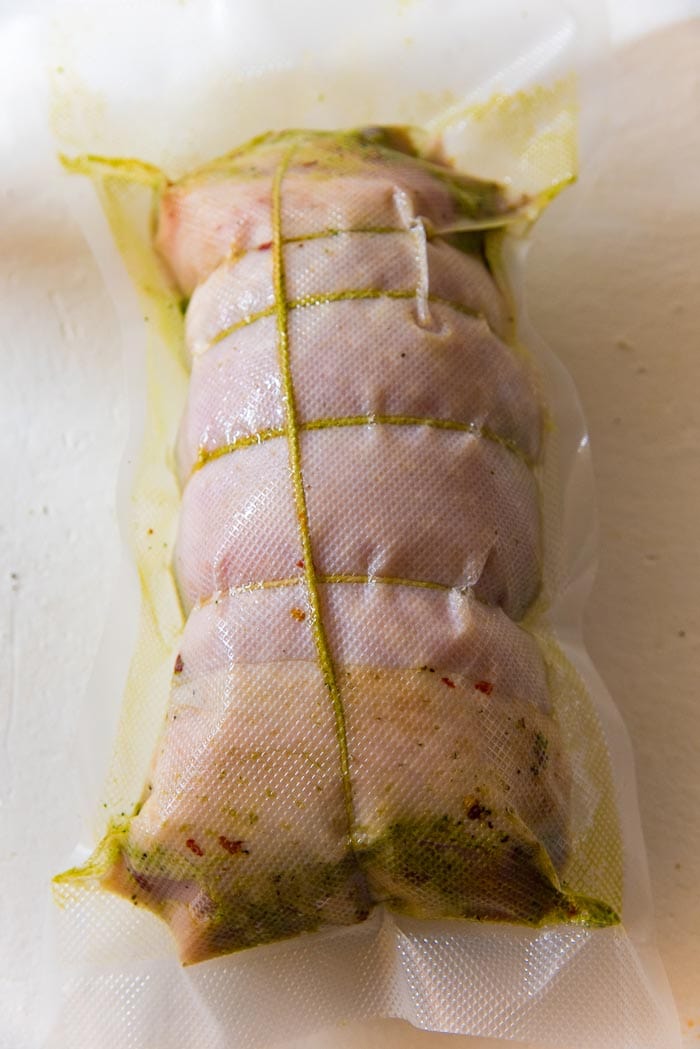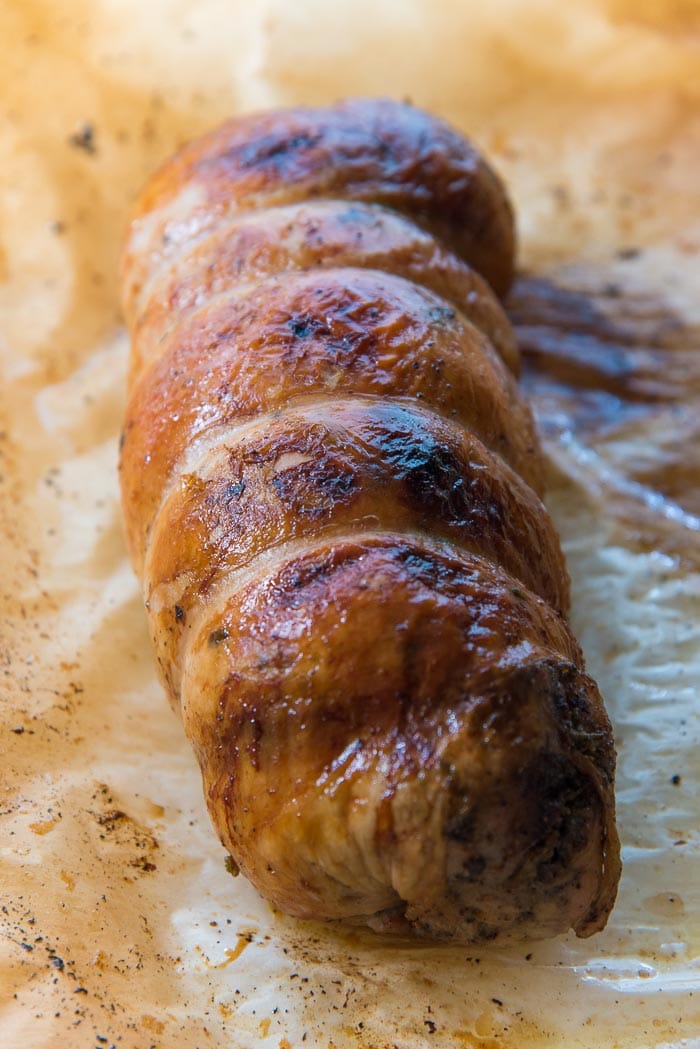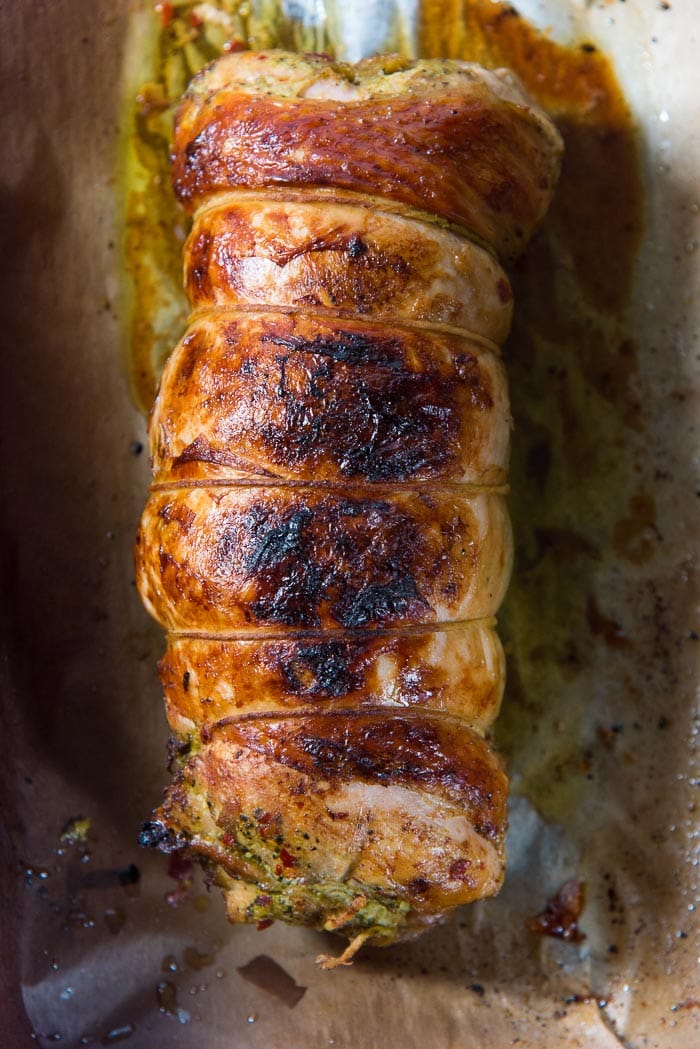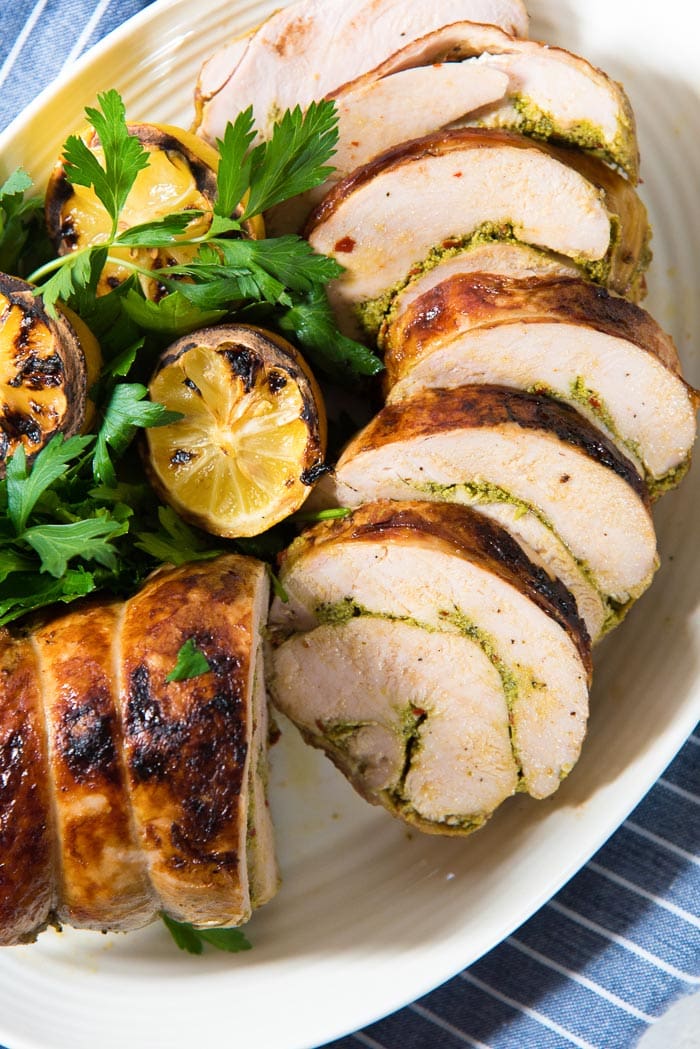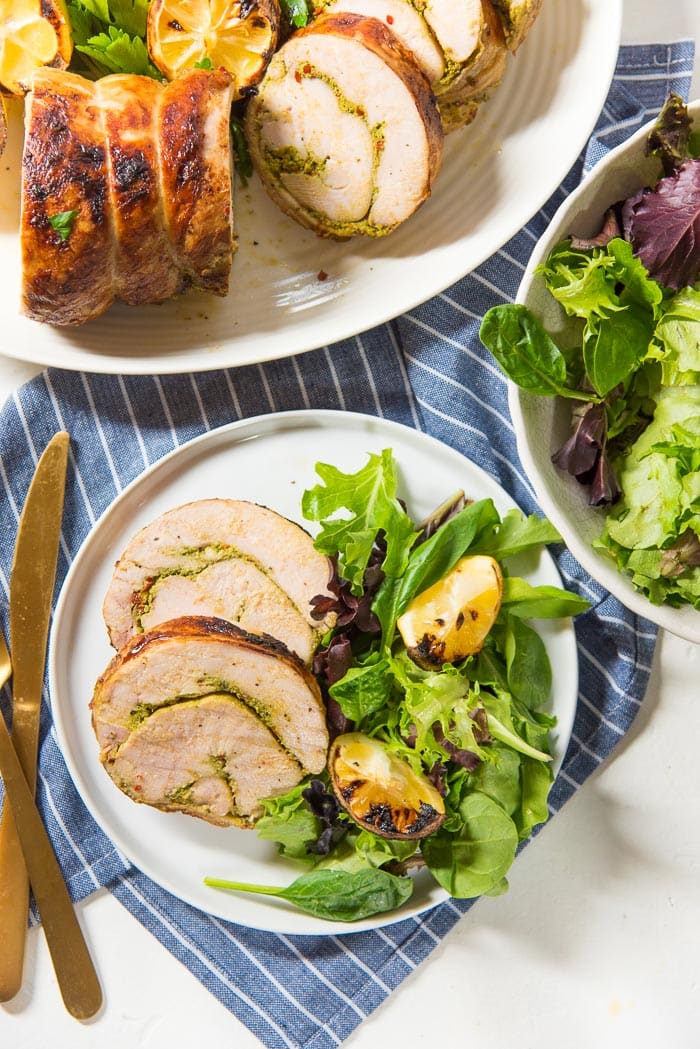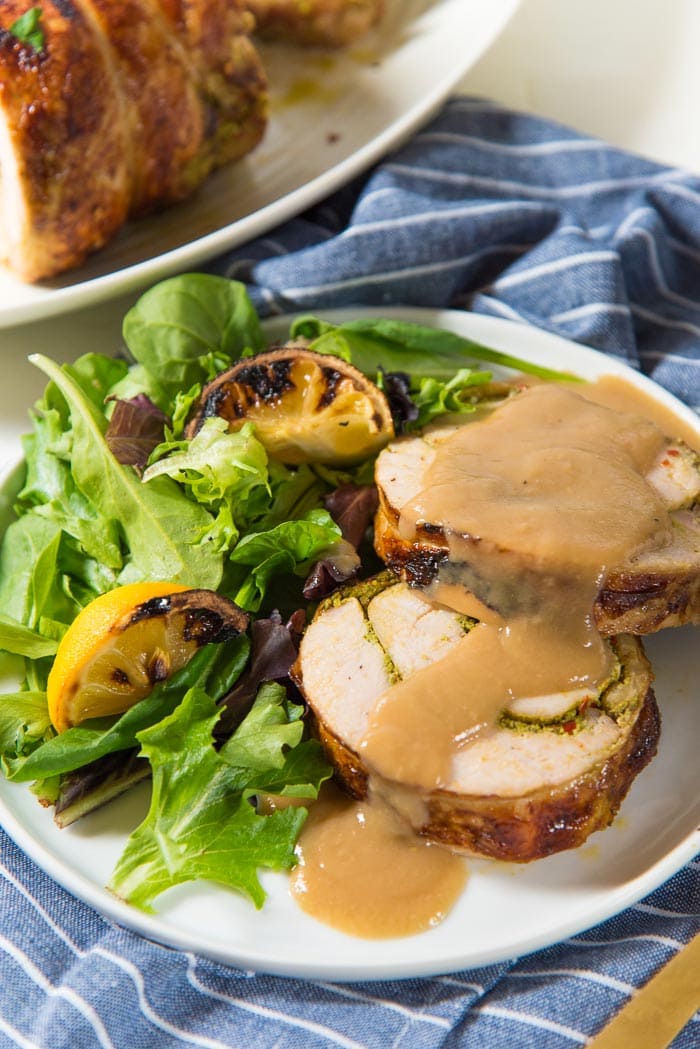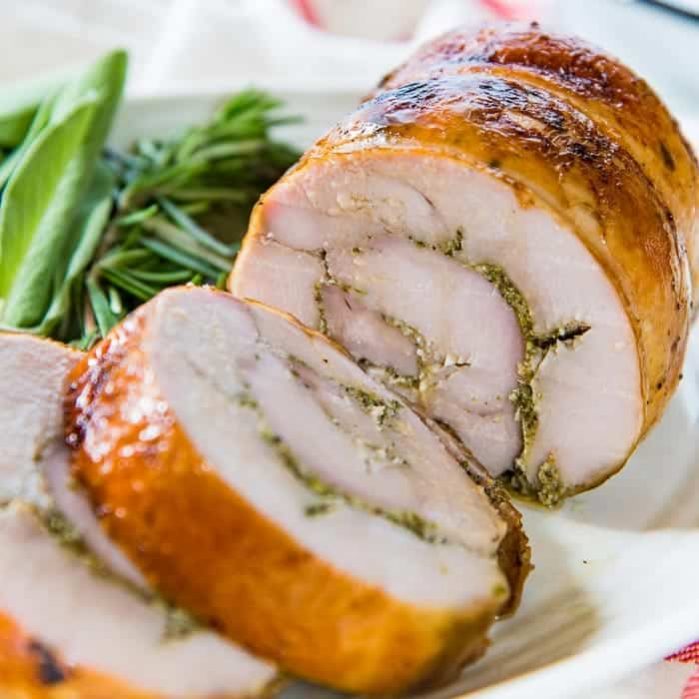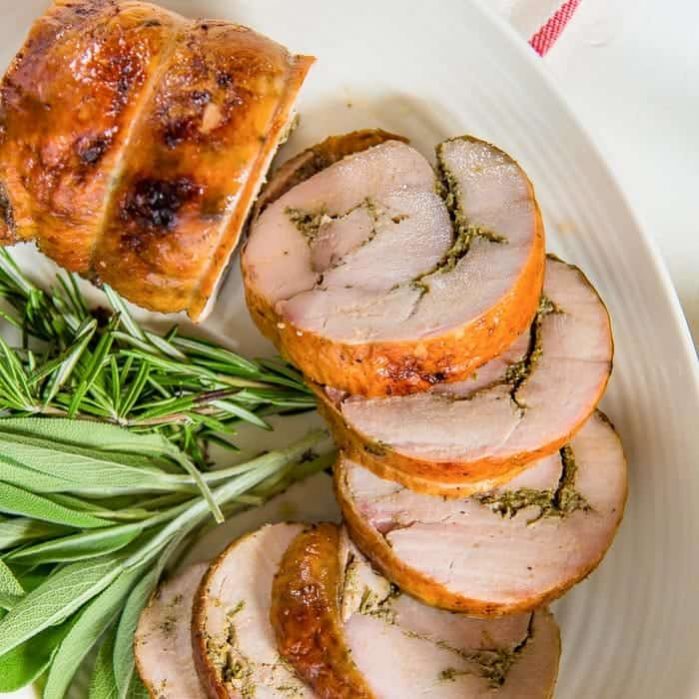Flavored with a lemon, garlic and herb spice mix, this sous vide turkey roulade is a great alternative to a whole bird for Thanksgiving or Christmas. I’ve discussed the technique and plenty of tips in the post below to ensure that you make the best sous vide turkey breast for your Thanksgiving and Christmas spread this year! Last time, I shared how to cook a perfectly slow roasted turkey roulade in the oven. Today, I’m sharing with you an even better and more precise way to cook a beautifully moist, succulent turkey roulade (turkey roll) in the sous vide! The most involved part about making a turkey roulade is actually prepping the turkey roll. I shared a detailed, step by step guide right here on how to make a turkey roulade, staring with a full turkey breast cut (on the bone, and with the skin). Once you’ve done that, you can use either your oven (oven roasted turkey roll) or make a sous vide turkey breast. The beauty about using a sous vide is that it’s nearly impossible to overcook this turkey roulade. It’s really that foolproof.
Why this sous vide turkey breast recipe works
I provide a detailed, step by step guide on how to perfectly debone a whole turkey breast yourself, and how to make a turkey roulade from scratch! Even if you have never made a roulade before, this guide will make it very easy and straightforward. Just like my oven roasted turkey roll, this is also a great way to cook turkey for Thanksgiving or Christmas for a small gathering OR if you want more meat but don’t need to cook a whole second bird. This post also shows you other flavor variations to adjust the recipe to your taste buds. The benefit of a roulade is that the cylindrical/roll shape allows for very even cooking, and cut even slices when serving this turkey roast to your guests. The benefit of sous vide is that you are guaranteed not to overcook the turkey breast! In fact, you’ll get the most juicy and succulent turkey breast this way. Plus, this is a show stopping turkey roast that will impress anyone.
Ingredients for this recipe
For the roulade
Whole turkey breast, bone in and skin on. OR turkey breast already made into a roulade/roll by your butcher Parsley Cilantro Sugar Lemon rind Lemon juice Chili Oil or butter Salt
For the gravy
Au jus from the roast Chicken stock Butter and flour for the roux Salt and pepper for seasoning
What is sous vide?
It sounds fancy, but it’s a pretty simple cooking technique, where your food is first sealed in a vacuum bag using a vacuum sealer, and then gradually heated (or cooked) in a temperature-regulated water bath. The water temperature is then set to whatever you want it to be, and your food is immersed in this sous vide water bath. Your food then gradually, and evenly, heats up to this temperature, and never overcooks because the temperature is kept constant throughout. I’ve been using my sous vide to cook proteins for a while now, especially steaks, because it cooks the meat evenly and guarantees perfectly tender, delicious results every time. I recently shared in this sous vide roast beef (sous vide chuck roast) post how I used my sous vide to cook a tough cut of meat like rump roast or chuck roast, which still comes out very tender without ever overcooking, every time, without fail. The sous vide that I own is an older model of ANOVA CULINARY, without bluetooth or wi-fi. It was about the same price as an Instant Pot pressure cooker now. However, I’ve noticed that Anova Culinary doesn’t sell this model anymore, but they do sell newer bluetooth (and wi-fi) capable models. You can find all the links to everything you need to start sous vide cooking below in this post.
Why sous vide turkey?
The low, consistent temperature of cooking in the sous vide will ensure a perfectly juicy and flavorful turkey breast. And because the internal temperature of the turkey won’t ever go above the water temp., there’s no risk of the turkey breast meat drying out either. The sous vide technique is easily the best of the two methods that I’ve shared to cook this turkey roll. All the flavors of parsley, cilantro, garlic and lemon permeate the meat and make each bite of this turkey roulade incredibly flavorful. And you will know when you slice into the meat, just how perfectly cooked it is. Really, I cannot stress enough how perfect this sous vide turkey breast is!
Why sous vide is one of the best ways to cook turkey breast
Turkey breast is notorious for its potential to go super dry after being roasted. Dry turkey breast is the main reason why most people prefer the thigh or leg portion of the bird, over the breast. Turkey thigh is best cooked at 165°F for optimal food safety and to eliminate potential Salmonella and other pathogens. At an internal temperature of 165°F, a 7-log10 reduction of pathogen count is achieved. Meaning 99.99999% of bacteria are instantly destroyed at this temperature. However, if you cook turkey breast at that temperature, it’ll come out dry. Sure, you can slather it with butter, but that’ll help the dryness only so much. Even with my slow roasted turkey roll in my previous post, I don’t exceed 162°F because this temperature ensures that the meat is deliciously succulent, while also being food-safe. However, the turkey continues to cook with residual heat and reach 165°F. The sous vide, on the other hand, lets you cook the turkey breast at an even lower temperature, slowly, until the entire cut of turkey breast reaches that temperature, while keeping it perfectly cooked and food safe.
How long to sous vide turkey breast, temperature, and food safety
I did quite a bit of research on the best cooking conditions and sous vide times to perfectly cook a moist, tender turkey breast before developing this recipe. According to the USDA FSIS cooking guideline for meat and poultry products, there is an instant 7-log10 reduction of Salmonella at an internal temperature of 165°F (73.9°C) for turkey meat with 1% all the way to 12% fat. However, the same 7-log reduction of pathogens can be achieved by maintaining a lower internal temperature for a longer time. For example, you will need an internal temperature of 160°F (71.1°C) for 25-27 seconds to achieve the same level of bacteria elimination and make the cooked meat food-safe. Similarly, at an internal temperature of 150°F (65.6°C), the turkey meat will require 3.7 to 4.9 minutes to fully cook to food-safe levels depending on the fat percentage. You can check page 38 of this PDF document for time-temperature combinations for turkey products of different fat percentages to achieve pathogen lethality. Kenji from Serious Eats also discusses this time-temperature dynamic of sous vide cooking turkey meat here and here. So, if you can maintain an internal temperature of 150 – 155°F for at least 4 – 5 minutes, then the meat is fully cooked to food-safe levels while being perfectly tender and juicy without ever running the risk of drying out. Sous vide cooking easily guarantees that, and the whole process is mostly hands-off. What’s not to love?
How to sous vide turkey breast
How to prep the turkey breast for sous vide cooking
I shared a full guide on how to make a turkey roulade, from preparing the turkey breasts to making a turkey roulade. Starting from a full turkey breast cut (with two turkey breast sections, bone in and skin on), to a boneless turkey breast roll that’s ready to sous vide. As you can imagine, this roulade shape guarantees even cooking throughout the meat, so that’s why I prefer to make a turkey breast roll / roulade for this sous vide recipe. I prefer refrigerating the turkey roll (that’s rolled and tied up, and then wrapped with plastic wrap) overnight (up to 24 hours). The turkey roulade is then unwrapped and patted dry with paper towels prior to being cooked.
Here’s where sous vide turkey breast differs from my oven roasted turkey roll
Instead of oil, I like to rub a little softened butter on the turkey roulade, although you’re welcome to use oil for dietary or nutritional reasons. I like the idea of the sous vide turkey breast being coated with butter for the entire cooking process. Since the cooking temp. is low, the butter won’t burn either. Add some salt to keep it seasoned as well. The turkey roulade is then sealed in a plastic bag that can be immersed in the sous vide bath.
You can seal the turkey roll in a bag using either of the following two methods
Setting up and cooking sous vide turkey breast
When the turkey roulade is sealed in snugly, attach your sous vide to the water container and set the temperature, and allow the water to reach that temperature. Remember to close the sous vide (with a lid or using sous vide plastic balls) to prevent evaporation. After cooking the sous vide turkey breast for 5 hours at 150°F, the turkey is then removed from the bag and patted dry with paper towels.
How to caramelize the skin
At this point, you can caramelize the turkey breast skin in one of three ways.
Juices from the sous vide bag
The sous vide bag will contain the juices (and the melted butter) from the sous vide turkey roll. This is equivalent to the pan drippings after oven roasting the turkey roulade. Don’t discard this! You can use the juices to either pour directly over the sous vide turkey roulade slices, OR use it to make a flavorful turkey gravy. You can pair this garlic and herb turkey roulade with any Thanksgiving side dish, or any roast dinner side dish. It’s a great alternative for a whole turkey for Thanksgiving, or even for Christmas. The leftovers are great for sandwiches and burgers the following day too.
Tips to ensure the most juicy, succulent sous vide turkey breast
The good news with this sous vide method is that this piece of equipment does all the work to ensure that you get tender, succulent turkey breast. Here are the tips you need to follow to ensure that your sous vide turkey breast is as perfect as it can be.
The spice or herb mix adds so much flavor to the roast as it cooks, so don’t skip it. Make sure that the roulade thickness is as even as possible. That’s the whole reason why we go with a roulade shape in the first place. This ensures that the whole roast has the same texture and juiciness throughout. Place the roast in a sous vide bag and seal it very well! I absolutely prefer to use a vacuum sealer here, instead of the water displacement method. That’s because the turkey roast needs to be sealed in well with no excess air! If the bag is not sealed properly or there is air in the bag, this air can expand as the turkey cooks. This can result in the turkey not cooking properly. Make sure the turkey roast is fully submerged in the water. You can use clips to clip the bag to the water vessel, and heavy items or other types of clips to keep the meat fully submerged. Don’t be concerned by the sous vide temperature. At 150 F (maintained for a period of time), the turkey will be fully cooked (as long as the meat is properly prepped and set up in the sous vide)! Since turkey meat starts to lose moisture beyond 160 F, the sous vide turkey roulade we cook here will guarantee that it’s the most tender, juicy turkey breast roast that you’ve ever had!
The importance of properly sealing the turkey roast
Unlike other sous vide recipes and cooking methods, cooking meat with a sous vide requires more care. This is because of the longer cooking time as well. Any air pockets in the bag that can expand in the heat will cause the turkey roast to float. If the roast floats above water, then the turkey will not cook through. This can also lead to the meat going bad, since it’s exposed to lower temperatures that are more optimal for bacteria growth. Having a well-sealed turkey roast helps to fully submerge the meat in the water and cook it properly.
Flavor variations
While you can use any spice mix of your choice, I made a lemon, garlic and herb spice mix with lemon, garlic, cilantro and parsley. But the great thing about this sous vide turkey roulade recipe is that you can incorporate any flavor profile you like! How about this sage and rosemary spice mix that I used for the slow roasted turkey roll? Or this cajun spice mix that I used for this oven roasted turkey breast. And this sage garlic butter paste from my slow cooker turkey breast recipe.
How to serve this sous vide turkey breast
Other turkey mains
I have shared several small dish turkey alternatives for Thanksgiving and Christmas.
Like this easy oven roasted turkey breast Or if you prefer slow cooking your Thanksgiving turkey breast instead, then try my perfect slow cooker turkey breast. And for another amazing turkey roulade recipe, try my slow roasted turkey roll.
Sides
Here are some delicious traditional Thanksgiving side dishes and other sides to serve with this roasted turkey breast.
Desserts
Delicious seasonal dessert recipes to pair with this sous vide turkey breast for Thanksgiving dinner (and Christmas too).
Storage instructions
This sous vide turkey breast roast should be stored the same way as any turkey roast. Slice the leftovers prior to storing, so that it’s easier to only remove what you need. FRIDGE – Leftovers will last about 3 days in the fridge, if stored in an airtight container. Just make sure that the temperature of the meat does not fluctuate between room temperature and chilled too often. Such fluctuations will increase the likelihood of the meat going bad. Only take what you need and reheat. FREEZER – Leftovers will last in the freezer for up to 3 months. Portion the leftover turkey as you like. Wrap the portions separately. OR place the turkey in an airtight container that is freezer-friendly, but with wax paper or parchment paper layered in between the portions. Wrapping the portions this way will ensure that the turkey won’t have freezer burns either. Only remove the portions you want and reheat as needed. As with any leftovers, check for changes in smell, taste, texture, or color. If there are any changes, please discard.
What do to with turkey leftovers
Here are some of my favorites options for roast turkey leftovers.
Thanksgiving leftover strata Leftover turkey sandwich Creamy turkey shepherd’s pot pie Turkey croque monsieur Turkey filo rolls Thanksgiving leftover savory bread pudding
All the tools and equipment to make this sous vide turkey breast
